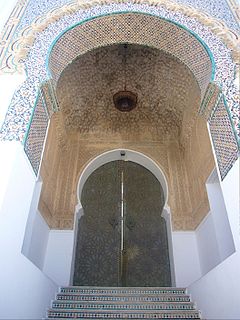 W
WAbu-al-Hasan Ali ben Abdallah al-Nuymari as-Shushtari or Al-Sustari was an Andalusian Sufi poet. His poetry was designed to be sung, in songs employing simple monorhymes to praise God with everyday musical idiom, which won wide recognition beyond the hundreds of disciples in his own Shushtariyya brotherhood.
 W
WAbu Madyan Shuʿayb ibn al-Husayn al-Andalusi, commonly known as Abū Madyan, was an influential Andalusian mystic and a great Sufi master.
 W
WIbn ʿArabi, full name Abū ʿAbd Allāh Muḥammad ibn ʿAlī ibn Muḥammad ibnʿArabī al-Ḥātimī aṭ-Ṭāʾī al-Andalusi al-Mursi al-Dimashqi, nicknamed al-Qushayri and Sultan al-'Arifin was an Arab Andalusian Muslim scholar, mystic, poet, and philosopher, whose works have grown to be very influential beyond the Muslim world. Out of the 850 works attributed to him, some 700 are authentic while over 400 are still extant. His cosmological teachings became the dominant worldview in many parts of the Islamic world.
Solomon ibn Gabirol was an 11th-century Andalusian poet and Jewish philosopher in the Neo-Platonic tradition. He published over a hundred poems, as well as works of biblical exegesis, philosophy, ethics and satire. One source credits ibn Gabirol with creating a golem, possibly female, for household chores.
 W
WIbn Jubayr, also written Ibn Jubair, Ibn Jobair, and Ibn Djubayr, was an Arab geographer, traveller and poet from al-Andalus. His travel chronicle describes the pilgrimage he made to Mecca from 1183 to 1185, in the years preceding the Third Crusade. His chronicle describes Saladin's domains in Egypt and the Levant which he passed through on his way to Mecca. Further, on his return journey, he passed through Christian Sicily, which had been recaptured from the Muslims only a century before, and he made several observations on the hybrid polyglot culture that flourished there.
 W
WAbu Abd Allah Muhammad ibn al-Husayn Ibn al-Kattani al-Madhiji (951–1029), sometimes nicknamed "al-Mutatabbib", was a well-known Arab scholar, philosopher, physician, astrologer, man of letters, and poet.
 W
WAbūʾl-Qāsim Aḥmad ibn al-Ḥusayn ibn Qasī was a Sufi, a rebel leader against the Almoravid dynasty in Al-Garb Al-Andalus and governor of Silves for the Almohads. The main sources for his life are Ibn al-Abbār, Ibn al-Khaṭīb and ʿAbd al-Wāḥid al-Marrakūshī. The last is the source for his biography in the biographical dictionary of al-Ṣafadī.
 W
WAbū al-Ḥasan ʿAlī ibn Mūsā ibn Saʿīd al-Maghribī (1213–1286), also known as Ibn Saʿīd al-Andalusī, was an Arab geographer, historian, poet, and the most important collector of poetry from al-Andalus in the 12th and 13th centuries.
 W
Wal-Mu'tamid Muhammad ibn Abbad Ibn Ismail al-Lakhmi was the third and last ruler of the taifa of Seville in Al-Andalus. He was a member of the Abbadid dynasty.
 W
WSidi Abu al-Qasim Abd al-Rahman b. Abd Allah al-Suhayli, was born in Al-Andalus, Fuengirola and died in Marrakesh. He is one of the seven saints of that city. Al-Suhayli wrote books on grammar and Islamic law. He is especially well known as an Islamic scholar by his commentary on the sira of Ibn Hisham. Al-Suhayli came to Marrakesh around 1182 at the call of the Almohad sultan Abu Yusuf Ya'qub al-Mansur. He died here three years later, and his zaouia, in a cemetery just outside Bab er Robb, hides a former gate in the wall called Bab el Charia. His tomb is visited yearly by many pilgrims. The cemetery Bab Ech Charia, walled today, is built at the place where the Almohad troops of Abd El Moumen defeated the Almoravids in 1147.